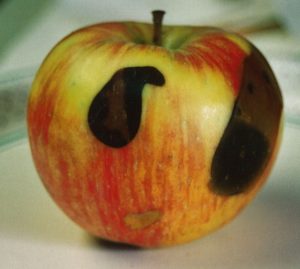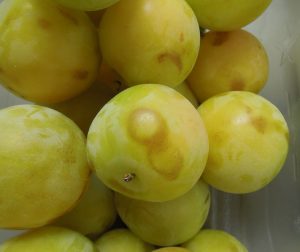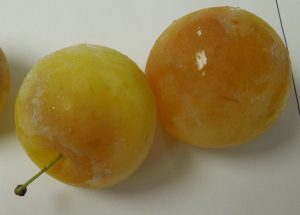Storage Disorders
Apple and pear flesh and skin can turn brown during storage. When browning occurs that is a natural process of aging rather than by infection from fungi, it is a disorder. Many types of disorders lead to loss of marketability, and vary with the relative maturity at harvest. Conditions in the orchard, such as fertility, and the variety can predispose fruit to certain disorders. In stone fruit, storage disorders are primarily due to cold temperatures and are grouped together as chilling injury.
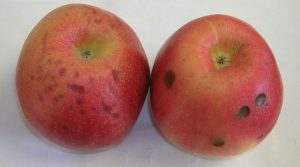
Bitter pit is a disorder that is partly caused by calcium deficiency in apple. It begins in the orchard, but the browning does not develop until after harvest. Small, sunken spots that are light or dark brown and located near the blossom end of the fruit are characteristic of this disorder. The browning can extend slightly into the flesh. Early harvest, high levels of nitrogen fertility, light crop load, and large fruit size increase its incidence. Honeycrisp is highly susceptible to bitter pit, so early harvest should be avoided in this variety. Jonagold, Granny Smith, and Cortland are also susceptible, but repeated foliar application of calcium products can prevent bitter pit in most cases. For Honeycrisp, foliar calcium applications should begin at petal fall and continue to harvest.
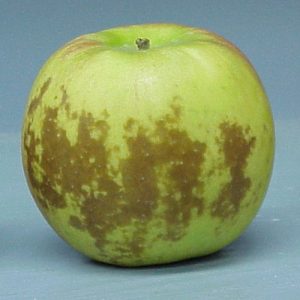
Superficial scald of apple is a skin browning disorder that develops in some varieties when they are cold stored longer than three months. Brown splotches develop on the green side of the apple, and will continue to grow in size when the apple is held at warm temperatures. It is also associated with early harvest date. Cortland, Red Delicious, McIntosh, and Granny Smith are susceptible and should be treated with an anti-scald agent prior to placement in cold or controlled atmosphere storage. Diphenylamine (DPA), 1-MCP and ethoxyquin are scald inhibiting agents labeled for use on apple. 1-MCP is not effective for preventing superficial scald in Cortland, so this variety should receive DPA when stored longer than three months. Gala, Honeycrisp, Golden Delicious, Empire, and SnowSweet are not susceptible to superficial scald.
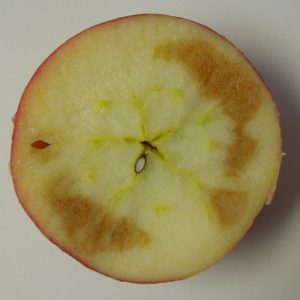
Soggy breakdown is an internal chilling injury that develops when susceptible varieties of apple are stored at a temperature below their tolerance. For Honeycrisp, temperatures below 37ºF can induce this disorder. Browning develops in the outer cortex. Severity of symptoms range from small brown spots in the cortex to a complete ring of browning around the entire apple that usually does not extend to the skin. There is usually ring of unaffected tissue just inside the skin. In Honeycrisp, it often co-occurs with soft scald. Conditioning the fruit before placement in cold storage does not consistently prevent soggy breakdown and in some cases, can make it more severe. It is recommended that Honeycrisp be stored at temperatures of 37 to 38ºF.
|
|
|
Soft scald is a chilling injury disorder that occurs when susceptible varieties of apple are stored at temperatures below their tolerance. Soft scald develops first as a light brown discoloration of the skin. It may extend into the flesh and closely resemble a bruise. Eventually, fungal decay will occur in the affected areas. Severity ranges from small spots to nearly the entire surface of the apple. Honeycrisp is highly susceptible to this disorder and can succumb at temperatures normally used for cold storage. Other varieties that can develop soft scald include Golden Delicious and McIntosh, but this rarely occurs at temperatures that are commonly used for apple storage. Late harvest also worsens symptoms.
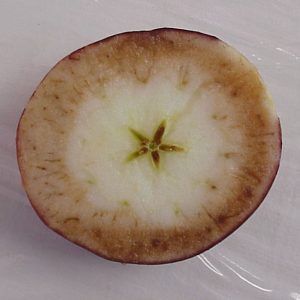
Another consequence of late harvest is the loss of apples to senescent breakdown, an aging disorder. Some varieties, such as Macoun, develop it after a few months in cold storage whereas other varieties, such as Red Delicious, can be stored several months without an occurrence. However, all varieties will eventually develop senescent breakdown if stored long enough. Harvest at the right maturity for the storage duration, cold temperatures, and controlled atmosphere storage are the most effective methods of delaying its occurrence. Application of 1-MCP is also effective in delaying it.
Lenticel breakdown in apple resembles bitter pit but is not isolated to the blossom end of the fruit. Brown circular areas develop over some of the lenticels. It is associated with a late harvest and long storage periods, but the exact cause is unknown. Honeycrisp is prone to this disorder.

Firm flesh browning occurs in Empire and McIntosh apples when stored for long durations at cold temperatures. It occurs more frequently with late harvest and the use of 1-MCP. Light browning occurs in the core and cortex. The flesh is discolored in a general manner with no distinct boundary between afflicted and healthy tissue. It is a difficult disorder to prevent since quality loss can occur if storage temperatures are above 35ºF, but the chance for browning increases at temperatures below this. The most effective method of prevention is harvesting at an early maturity for apples that will be stored longer than four months.
Vibrational bruises can occur in some varieties of plum such as Shiro. Shortly after transporting plums from the orchard, brown circles appear on the skin of sensitive varieties. When transporting plums from the orchard to the packing house or farm market, take steps to reduce movement of fruit in harvest containers.
Chilling injury in stone fruit manifests itself in a number of ways. Flesh color can change from normal to brown and can become translucent. In some cases, the flesh becomes stringy or mealy.


